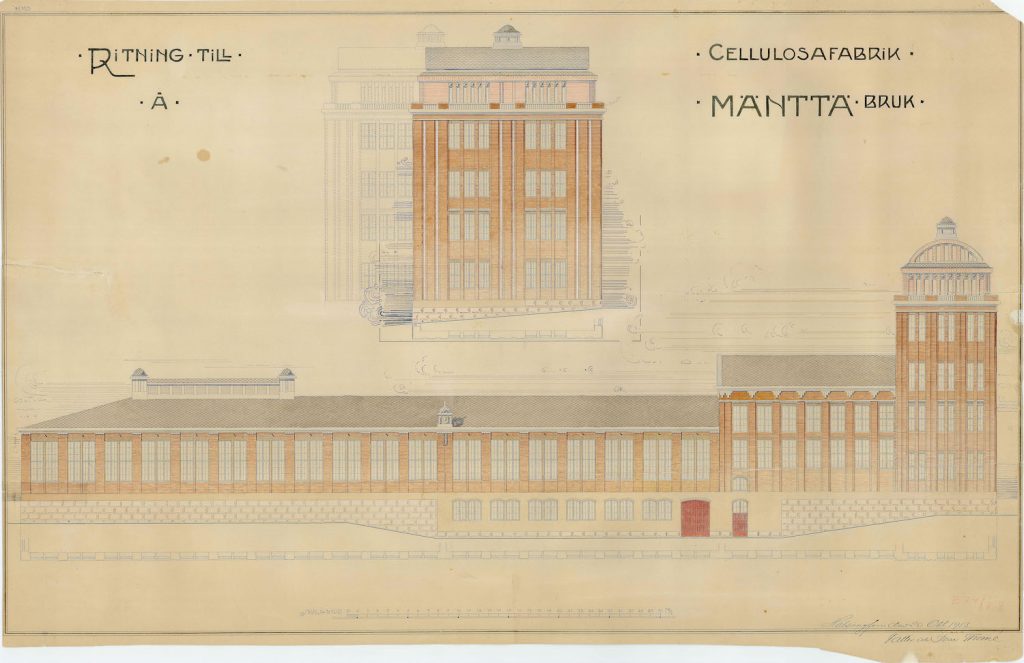Facade Drawing of Mänttä Pulp Mill
MARCH 2020
In 1913, G. A. Serlachius Ltd. established in Mänttä a sulphite pulp mill, the façade drawings of which were commissioned of the architect office of Valter and Ivar Thomé. The drawing, dated 20 October 1913, belongs to the entity of almost 10 000 drawings on Mänttä pulp mill comprised in the Serlachius Museums’ collection.
Paper manufacture started in Mänttä in 1881. At that time, the stock used was ground wood pulp from Mänttä and Vilppula groundwood mills which yielded brown paper as an end product. Demand for lighter paper arts manufactured of pulp increased, and already Gustaf Adolf Serlachius had in his time envisaged building a pulp mill in Mänttä. Pulp production started in Finland in 1872. The pulp mill in Mänttä was Finland’s nineteenth in row. Engineers A. M. Hedbäck and John Hedbäck were responsible for its planning. The façade drawings were commissioned of Valter and Ivar Thomé, who subsequently made drawings also for the pulp mills in Kemi, Pori, Varkaus and Rauma.
When the Mänttä pulp mill began its operations in 1914, it consisted of four buildings: debarking plant, acid department, steam power station and an entity of digesting plant, pulp pits and drying department. The drawing that has been named as pulp mill portrays the latter of these depicted from Mäntänlahti or looking from the south. In regard of the manufacturing process, the facade drawing of Mänttä pulp mill has to be read from right to left.
The tower-like section is digesting plant which contained two digesters when completed. Each cylindrical digester had a dome-shaped top, funnel-shaped conical bottom, and occupied three floors completely. The fourth floor housed the digester’s filling units and a kind of a funnel through which the woodchips ran down to fill the digester. The top floor of the digesting plant was the so-called chip loft, which housed the chip conveying equipment.
The pulp was drained from the digesters to the pulp pits for washing, after which it was defiberated in separators. This stage took place in the two-floor high space next to digesting plant. This was followed by the screening department, where the impurities were removed from the pulp, such as branches or sand, and the pulp was thickened.
The pulp was conveyed wet to the adjoining paper mill. The pulp that was sold to other mills, however, had to be dried and packed in bales for transport. The uttermost end of the low section concealed a drying machine, at which the porridge-like pulp was dewatered, and excess water was removed with wires, drying cylinders and hot steam. Before their storage, baling constituted the last stage, at which the square pulp sheets were compiled and packaged into 250-kilogramme bales.
On completion, the building was in regard of its layout rectangular in shape all the way from the digesting plant up to the end section of the drying department, where it tapered diagonally. After a few years, it was extended and also the drying department section became rectangular in shape. In anticipation of future development, an extension of the digesting department has been drawn above the main image. The number of digesters increased over time from two to no less than ten, and the building was expanded several times in north-south direction. The digesters were aligned in one row, which resulted in narrow, high and elongated form of the digesting plant.
Mänttä pulp mill was closed in 1991. During almost 80 years of its operation, the capacity of the mill was increased, and the process developed. As a result, the original building depicted in the drawing from the year 1913 has gradually melted itself in the new strata. When travelling on the road and passing by the building, one can discern the eastern façade of the digesting plant. The original shape of the building is recognisable when looking across Mäntänlahti or down the Mäntänvuori Hill.
Milla Sinivuori-Hakanen
Curator
Sources:
Drawings of Mänttä Pulp Mill, Serlachius Museums, Drawing collection.
Hovi-Wasastjerna Päivi, Arkkitehti Valter Thomé – Harmoniaa etsimässä. Hämeenlinna 2009.
Norrmén P. H., Mäntän tehdas 1968–1928. 1928.
Operation reports of the pulp mill (Selluloosatehtaan toimintakertomukset) 1917–1954, Archives of G. A. Serlachius Oy, ELKA.


